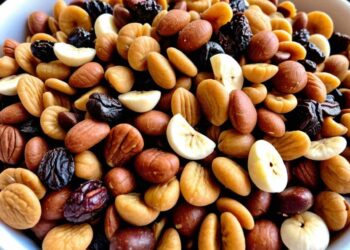Introduction:
Trail mix is a popular snack among hikers, athletes, and health-conscious individuals. It offers a balanced combination of nuts, seeds, dried fruits, and sometimes chocolate or granola. Among its essential components, dehydrated bits play a crucial role in enhancing flavor, providing nutritional benefits, and extending shelf life. This article delves into everything you need to know about dehydrated bits in trail mix, including their types, benefits, preparation, storage, and how to create the perfect mix.
What Are Dehydrated Bits?
Dehydrated bits in trail mix refer to pieces of food—primarily fruits and vegetables—that have undergone the dehydration process to remove moisture, preserving their nutrients and flavor while extending their usability. Unlike fresh ingredients, dehydrated bits have a significantly longer shelf life and offer a concentrated burst of flavor.
Common Types of Dehydrated Bits in Trail Mix:
- Dehydrated Fruits
- Bananas (banana chips)
- Apples (apple chips or rings)
- Strawberries
- Blueberries
- Mangoes
- Pineapples
- Cranberries (often sweetened)
- Apricots
- Dehydrated Vegetables (less common but increasingly popular)
- Sweet potatoes
- Carrots
- Beets
- Zucchini
- Other Dehydrated Ingredients
- Coconut flakes
- Yogurt-covered fruits (technically dehydrated with coatings)
- Protein crisps
- Cereal puffs
Benefits of Dehydrated Bits in Trail Mix:
1. Longer Shelf Life
Dehydrated ingredients last much longer than fresh fruits and vegetables. When stored properly, they can remain edible for months or even years without refrigeration.
2. Nutrient Retention
Dehydration preserves many essential nutrients, including vitamins, minerals, and fiber. Though some vitamin loss (especially vitamin C) can occur, many dehydrated foods retain their health benefits.
3. Convenience and Portability
Dehydrated bits are lightweight and easy to carry, making them an ideal snack for hiking, camping, or travel. Their reduced weight compared to fresh fruits and vegetables makes them a go-to option for energy-dense nutrition on the go.
4. Natural Sweetness Without Artificial Additives
Unlike processed candies or artificial sweets, dehydrated fruits provide natural sugars that fuel the body without unnecessary additives or preservatives.
5. Texture and Flavor Enhancement
Dehydrated ingredients add unique textures and flavors to trail mix. Whether crispy banana chips, chewy mango slices, or crunchy apple bits, they provide variety and enhance the overall snacking experience.
Can THC Dehydrate You – Understanding the Effects of Cannabis on Hydration!
How to Dehydrate Fruits and Vegetables for Trail Mix?
1. Choosing the Right Ingredients
- Pick ripe and fresh fruits or vegetables.
- Wash and slice them evenly to ensure uniform dehydration.
2. Methods of Dehydration
- Using a Dehydrator: The most efficient method, allowing precise temperature control.
- Oven Drying: Set the oven to the lowest temperature (usually 140–170°F or 60–75°C) and bake for several hours.
- Sun Drying: Works best in hot, dry climates but takes longer.
- Freeze Drying: A more advanced method that retains more nutrients and texture but requires special equipment.
3. Storage Tips
- Store dehydrated bits in airtight containers.
- Use vacuum-sealed bags to further extend shelf life.
- Keep them in a cool, dry place away from direct sunlight.
- Add silica gel packs to absorb moisture and prevent spoilage.
How to Build the Perfect Trail Mix with Dehydrated Bits?
1. Base Ingredients
A good trail mix should include a balance of proteins, healthy fats, carbohydrates, and fibers. Common components include:
- Nuts (almonds, cashews, walnuts, pecans)
- Seeds (sunflower, pumpkin, chia, flax)
- Dehydrated bits (fruits and vegetables)
- Whole grains (granola, oats, cereal puffs)
- Dark chocolate chips (for an energy boost)
2. Flavor Combinations
Here are some tasty mixes incorporating dehydrated bits:
- Tropical Mix: Dehydrated mango, pineapple, coconut flakes, cashews, and almonds.
- Berry Blast: Dehydrated strawberries, blueberries, cranberries, walnuts, and pumpkin seeds.
- Sweet & Savory: Dehydrated sweet potatoes, banana chips, pecans, sunflower seeds, and dark chocolate.
- Superfood Mix: Dehydrated beets, goji berries, almonds, flaxseeds, and cacao nibs.
3. Avoiding Common Pitfalls
- Too Much Sugar: Some store-bought dehydrated fruits have added sugar. Opt for unsweetened versions.
- Overly Processed Ingredients: Stick to whole, natural ingredients without artificial preservatives.
- Unbalanced Ratios: Aim for a good mix of nuts, seeds, and dehydrated bits to avoid an overly sweet or heavy blend.
Storing and Preserving Trail Mix:
To maintain freshness:
- Use airtight containers to prevent moisture absorption.
- Keep trail mix in a cool, dark place to extend shelf life.
- Refrigerate or freeze if storing for extended periods (especially if it contains chocolate or yogurt-coated bits).
Conclusion:
Dehydrated bits are an essential component of trail mix, offering numerous benefits such as enhanced flavor, convenience, and long shelf life. By choosing the right ingredients and preparation methods, you can create a delicious and nutritious trail mix suited to your dietary needs. Whether you’re hiking, working, or simply looking for a healthy snack, incorporating dehydrated fruits and vegetables into your trail mix is a great way to fuel your body naturally. Happy snacking!
Also Read:









Discussion about this post